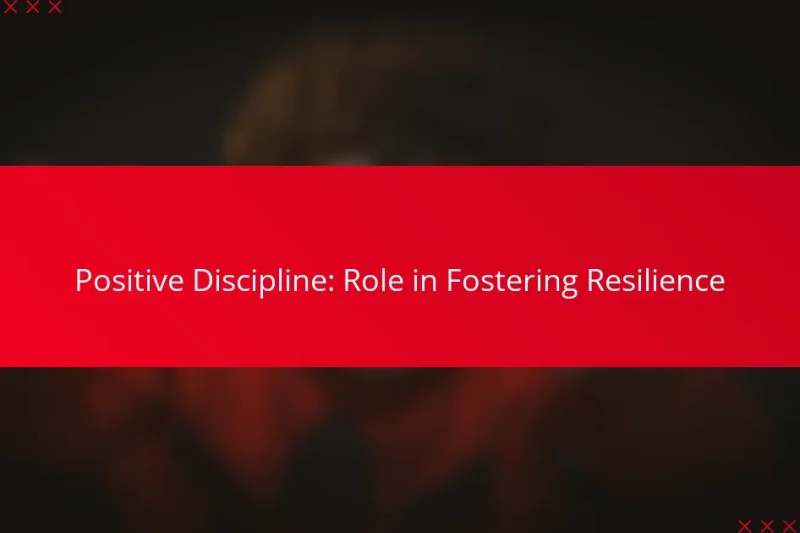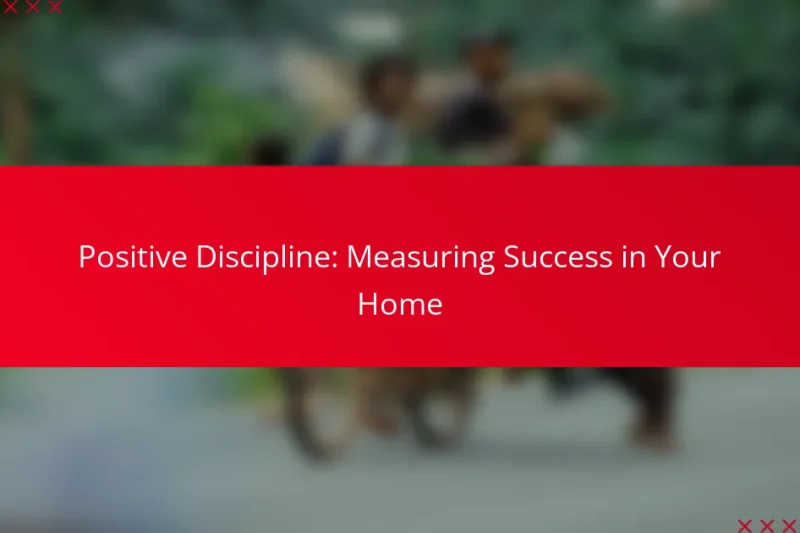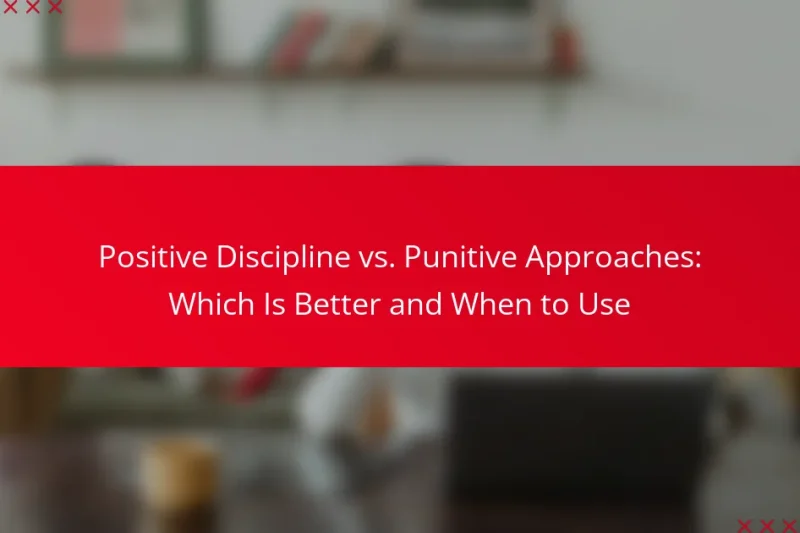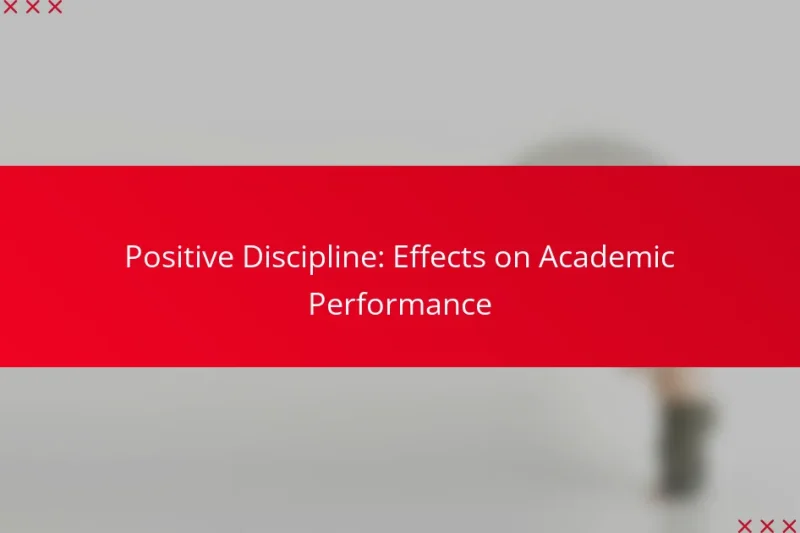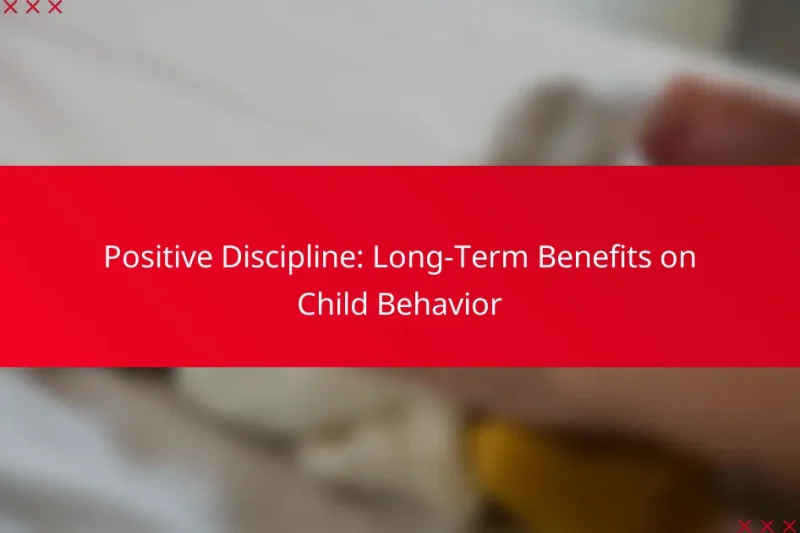Positive Discipline plays a crucial role in fostering resilience in children by equipping them with essential … Positive Discipline: Role in Fostering ResilienceRead more
Benefits of Positive Discipline for Child Development
Positive Discipline plays a vital role in child development by creating a supportive environment that promotes learning and growth. By emphasizing guidance over punishment, it helps children develop essential life skills such as self-control and responsibility, fostering respectful relationships between parents and children.
Positive Discipline: Measuring Success in Your Home
Positive discipline is an effective approach for nurturing children’s behavior through encouragement and guidance rather than … Positive Discipline: Measuring Success in Your HomeRead more
Positive Discipline vs. Punitive Approaches: Which Is Better and When to Use
When it comes to guiding children’s behavior, the choice between Positive Discipline and punitive approaches can … Positive Discipline vs. Punitive Approaches: Which Is Better and When to UseRead more
Positive Discipline: Effects on Academic Performance
Positive discipline plays a vital role in enhancing academic performance by creating a nurturing and supportive … Positive Discipline: Effects on Academic PerformanceRead more
Positive Discipline: Long-Term Benefits on Child Behavior
Positive discipline is an effective approach that enhances child behavior by emphasizing understanding and cooperation instead … Positive Discipline: Long-Term Benefits on Child BehaviorRead more
Positive Discipline: Contribution to Emotional Intelligence Development
Positive Discipline plays a vital role in developing emotional intelligence in children by equipping them with … Positive Discipline: Contribution to Emotional Intelligence DevelopmentRead more
Positive Discipline: Impact on Family Dynamics
Positive Discipline significantly enhances family dynamics by fostering respectful interactions and effective communication among all members. … Positive Discipline: Impact on Family DynamicsRead more
How does Positive Discipline benefit child development?
Positive Discipline benefits child development by fostering a nurturing environment that encourages learning and growth. It focuses on teaching children appropriate behaviors through guidance rather than punishment, which helps them develop essential life skills.
Promotes emotional intelligence
Positive Discipline enhances emotional intelligence by helping children recognize and understand their feelings. Through discussions and role-playing, children learn to express emotions appropriately and empathize with others, which is crucial for building social skills.
For example, when a child feels frustrated, a parent can guide them to articulate their feelings instead of reacting with anger. This practice not only improves emotional awareness but also equips children with tools to manage their emotions effectively.
Encourages responsible behavior
This approach encourages responsible behavior by setting clear expectations and consequences. Children learn that their actions have impacts, which fosters accountability and decision-making skills.
For instance, if a child forgets to complete their homework, instead of punishment, a parent might discuss the importance of responsibility and help them create a plan to manage their time better in the future.
Enhances self-discipline
Positive Discipline enhances self-discipline by teaching children to make choices and understand the results of those choices. This method emphasizes the importance of self-regulation and personal responsibility.
Parents can support this by allowing children to set personal goals and reflect on their progress. For example, a child might decide to limit screen time in favor of reading, learning to prioritize tasks effectively.
Builds strong parent-child relationships
Strong parent-child relationships are cultivated through the respectful and supportive nature of Positive Discipline. When parents engage with their children positively, it fosters trust and open communication.
Regular family meetings can be a practical way to strengthen these bonds, allowing children to voice their opinions and feel valued. This collaborative approach encourages mutual respect and understanding.
Fosters resilience
Positive Discipline fosters resilience by teaching children how to cope with challenges and setbacks. Instead of shielding them from difficulties, this approach encourages problem-solving and perseverance.
For example, when a child faces a disappointment, parents can guide them through the experience, helping them identify lessons learned and strategies for future success. This builds a mindset that embraces challenges as opportunities for growth.
What are effective Positive Discipline techniques?
Effective Positive Discipline techniques focus on teaching children self-control and responsibility while fostering a respectful relationship. These methods emphasize guidance over punishment, helping children learn from their mistakes in a supportive environment.
Setting clear expectations
Setting clear expectations involves communicating specific rules and behaviors to children. This clarity helps them understand what is acceptable and what is not, reducing confusion and frustration. For example, instead of saying “be good,” specify “please keep your toys in the playroom.”
To reinforce these expectations, consider using visual aids like charts or checklists. Regularly reviewing these guidelines can help children internalize the rules and promote accountability.
Using natural consequences
Using natural consequences means allowing children to experience the results of their actions in a safe manner. For instance, if a child refuses to wear a jacket on a chilly day, they may feel cold, which teaches them the importance of dressing appropriately. This approach encourages critical thinking about their choices.
It’s essential to ensure that the consequences are logical and related to the behavior. Avoid using harsh or unrelated consequences, as these can lead to resentment rather than learning.
Encouraging problem-solving skills
Encouraging problem-solving skills involves guiding children to find solutions to their conflicts or challenges. Instead of immediately stepping in to resolve an issue, ask questions like “What do you think you can do?” This empowers them to think critically and develop independence.
To facilitate this process, create a safe space for discussion where children feel comfortable expressing their thoughts. Role-playing different scenarios can also be a fun way to practice these skills.
Implementing time-outs effectively
Implementing time-outs effectively means using them as a tool for reflection rather than punishment. A time-out should be a brief period, typically around one minute for each year of the child’s age, allowing them to calm down and think about their behavior.
Ensure that the time-out location is neutral and free from distractions. After the time-out, discuss the behavior with the child to reinforce understanding and encourage better choices in the future.
What role do parents play in Positive Discipline?
Parents play a crucial role in Positive Discipline by guiding their children through clear expectations and supportive interactions. They model behavior, maintain consistency, communicate effectively, and help children manage their emotions, all of which contribute to healthy development.
Modeling appropriate behavior
Modeling appropriate behavior involves demonstrating the actions and attitudes you want your child to adopt. Children learn by observing their parents, so displaying kindness, patience, and respect in daily interactions sets a strong example. For instance, when you handle frustration calmly, your child is more likely to emulate that response.
It’s beneficial to discuss your thought process aloud, explaining why you choose to act in a certain way. This not only reinforces the behavior but also helps children understand the reasoning behind it.
Maintaining consistency
Consistency is key in Positive Discipline, as it helps children understand expectations and the consequences of their actions. Establishing clear rules and sticking to them creates a sense of security and predictability. For example, if a child knows that bedtime is always at 8 PM, they are more likely to comply with that routine.
Parents should also ensure that all caregivers are on the same page regarding rules and consequences. This unified approach prevents confusion and reinforces the importance of the guidelines set for the child.
Communicating openly
Open communication fosters trust and understanding between parents and children. Encourage your child to express their feelings and thoughts, and actively listen to them without judgment. This practice not only validates their emotions but also teaches them how to articulate their feelings effectively.
Using age-appropriate language and asking open-ended questions can enhance these conversations. For instance, instead of asking, “Did you have a good day?” try “What was the best part of your day?” to encourage more detailed responses.
Supporting emotional regulation
Supporting emotional regulation involves teaching children how to manage their feelings in a healthy way. Parents can help by acknowledging emotions and providing strategies for coping, such as deep breathing or counting to ten. This guidance empowers children to handle their emotions constructively.
Engaging in activities that promote emotional awareness, like reading books about feelings or role-playing different scenarios, can also be effective. These practices help children recognize their emotions and develop the skills needed to respond appropriately in various situations.
How can educators apply Positive Discipline in schools?
Educators can apply Positive Discipline in schools by fostering a respectful and supportive atmosphere that encourages students to learn from their mistakes. This approach emphasizes guidance and understanding rather than punishment, helping children develop self-discipline and responsibility.
Creating a supportive classroom environment
A supportive classroom environment is crucial for implementing Positive Discipline. This can be achieved by establishing clear expectations and routines, which help students feel secure and understand what is required of them. Regularly acknowledging positive behaviors reinforces a sense of community and belonging.
Additionally, creating a physical space that is inviting and organized can enhance learning. Use colorful displays, comfortable seating, and accessible resources to make the classroom a welcoming place where students feel motivated to participate.
Incorporating social-emotional learning
Incorporating social-emotional learning (SEL) into the curriculum is essential for Positive Discipline. SEL teaches students to recognize and manage their emotions, set positive goals, and develop empathy for others. This skill set is vital for fostering respectful interactions and resolving conflicts peacefully.
Educators can integrate SEL through activities such as role-playing, group discussions, and reflective journaling. These practices not only enhance emotional intelligence but also promote a culture of understanding and cooperation among students.
Collaborating with parents
Collaboration with parents is a key component of Positive Discipline. Engaging parents in the educational process helps create a consistent approach to discipline at home and school. Regular communication through newsletters, meetings, or workshops can keep parents informed and involved.
Encourage parents to share their insights and strategies for managing behavior at home. This partnership can lead to a unified approach that supports children’s development and reinforces the principles of Positive Discipline both in school and at home.
What are common misconceptions about Positive Discipline?
Many people mistakenly believe that Positive Discipline equates to permissiveness or a lack of boundaries. In reality, it emphasizes teaching children self-discipline and responsibility while maintaining a nurturing environment.
Positive Discipline is just about being nice
A common misconception is that Positive Discipline focuses solely on being kind and gentle. While kindness is a crucial element, the approach also involves setting clear expectations and consequences. This balance helps children learn appropriate behavior while feeling supported.
For example, instead of simply allowing a child to avoid chores, Positive Discipline encourages parents to explain the importance of responsibility and involve the child in finding solutions, fostering both respect and accountability.
It means no consequences for bad behavior
Another myth is that Positive Discipline lacks consequences for misbehavior. In fact, it incorporates constructive consequences that are designed to teach rather than punish. This method helps children understand the impact of their actions and promotes better decision-making in the future.
For instance, if a child misuses a toy, a constructive consequence might involve putting it away for a short period, allowing the child to reflect on their actions while still feeling secure in their environment.
Positive Discipline is only for younger children
Some believe that Positive Discipline is only effective for young children. However, this approach can be beneficial for children of all ages, including teenagers. As children grow, the principles of Positive Discipline can adapt to their developmental stages, promoting ongoing communication and respect.
For teens, Positive Discipline might involve collaborative discussions about rules and consequences, helping them feel more involved and responsible for their choices, which can lead to better outcomes.
